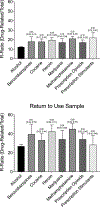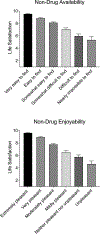A brief measure of non-drug reinforcement: Association with treatment outcomes during initial substance use recovery
- PMID: 38266572
- PMCID: PMC10922801
- DOI: 10.1016/j.drugalcdep.2024.111092
A brief measure of non-drug reinforcement: Association with treatment outcomes during initial substance use recovery
Abstract
Background: Translational research demonstrates that drug use is inversely associated with availability and engagement with meaningful non-drug reinforcers. Evaluation of non-drug reinforcement in treatment-receiving clinical populations is limited, likely owing to the time intensive nature of existing measures. This study explores the association of non-drug reinforcers with treatment outcomes using a novel, brief measure of past month non-drug reinforcement quantifying three elements: relative frequency, access, and enjoyability.
Methods: Respondents enrolled in substance use treatment (residential, intensive outpatient, and medically managed withdrawal) in clinics across the United States (N = 5481) completed standardized assessments of non-drug reinforcement and treatment outcomes (i.e., return to use and life satisfaction) one-month after treatment discharge. Non-drug reinforcement measures (availability, engagement, enjoyability) were used as predictors of return to use and life satisfaction using generalized linear models.
Results: Non-drug reinforcement indices were associated with return to use and life satisfaction in unadjusted models (e.g., 12.4 % versus 58.3 % return to use for those with the highest and lowest availability, respectively). Consistent results were observed in models adjusted for sociodemographic variables and risk factors (i.e., sleep disturbance, anhedonia, stress). Comparisons by drug class generally showed lower non-drug reinforcement among patients reporting heroin or methamphetamine as their primary drug.
Conclusions: Results highlight the importance of non-drug reinforcement during the first month following treatment. Rapid measurement of non-drug reinforcement in stepped care settings may illuminate critical deficits in early stages of behavior change, identify those at greatest risk for return to use, and provide targets for treatment to improve recovery trajectories.
Keywords: Addiction; Behavioral Economics; Partial Hospitalization; Stepped Care; Substance Use.
Copyright © 2024 Elsevier B.V. All rights reserved.
Conflict of interest statement
Declaration of Competing Interest The authors have no conflicts of interest to disclose.
Figures




Similar articles
-
Recovery schools for improving behavioral and academic outcomes among students in recovery from substance use disorders: a systematic review.Campbell Syst Rev. 2018 Oct 4;14(1):1-86. doi: 10.4073/csr.2018.9. eCollection 2018. Campbell Syst Rev. 2018. PMID: 37131375 Free PMC article.
-
Measurement of substance-free reinforcement in addiction: A systematic review.Clin Psychol Rev. 2019 Jun;70:79-90. doi: 10.1016/j.cpr.2019.04.003. Epub 2019 Apr 5. Clin Psychol Rev. 2019. PMID: 30991244 Free PMC article.
-
Substance use negatively impacts change in reinforcement during the year following substance use treatment.Psychol Addict Behav. 2025 May;39(3):238-253. doi: 10.1037/adb0001051. Epub 2025 Jan 9. Psychol Addict Behav. 2025. PMID: 39786834
-
Polydrug use and its association with drug treatment outcomes among primary heroin, methamphetamine, and cocaine users.Int J Drug Policy. 2017 Nov;49:32-40. doi: 10.1016/j.drugpo.2017.07.009. Epub 2017 Sep 6. Int J Drug Policy. 2017. PMID: 28888099 Free PMC article.
-
Anhedonia, Hyperkatifeia, and Negative Reinforcement in Substance Use Disorders.Curr Top Behav Neurosci. 2022;58:147-165. doi: 10.1007/7854_2021_288. Curr Top Behav Neurosci. 2022. PMID: 35112332 Review.
Cited by
-
Contextual and psychosocial factors influencing drug reward in humans: The importance of non-drug reinforcement.Pharmacol Biochem Behav. 2024 Aug;241:173802. doi: 10.1016/j.pbb.2024.173802. Epub 2024 Jun 10. Pharmacol Biochem Behav. 2024. PMID: 38866372 Free PMC article. Review.
-
Mechanistic and translational insights from preclinical cocaine choice procedures on the economic substitutability of cocaine and nondrug reinforcers.Neurosci Biobehav Rev. 2025 Aug;175:106217. doi: 10.1016/j.neubiorev.2025.106217. Epub 2025 May 21. Neurosci Biobehav Rev. 2025. PMID: 40409443 Review.
-
Perceived stigma and its role in substance use disorder treatment completion.Am J Drug Alcohol Abuse. 2025 Jul 31:1-11. doi: 10.1080/00952990.2025.2528778. Online ahead of print. Am J Drug Alcohol Abuse. 2025. PMID: 40743445
-
Assessment of contextualized reinforcement pathology in a community sample of young adult substance users.Alcohol Clin Exp Res (Hoboken). 2025 Jun;49(6):1263-1272. doi: 10.1111/acer.70050. Epub 2025 Apr 11. Alcohol Clin Exp Res (Hoboken). 2025. PMID: 40214283 Free PMC article.
-
Human laboratory models of reward in substance use disorder.Pharmacol Biochem Behav. 2024 Aug;241:173803. doi: 10.1016/j.pbb.2024.173803. Epub 2024 Jun 4. Pharmacol Biochem Behav. 2024. PMID: 38843997 Free PMC article. Review.
References
-
- Ahmed SH, 2018. Individual decision-making in the causal pathway to addiction: contributions and limitations of rodent models. Pharmacology Biochemistry and Behavior 164, 22–31. - PubMed
-
- Andersson HW, Wenaas M, Nordfjærn T, 2019. Relapse after inpatient substance use treatment: A prospective cohort study among users of illicit substances. Addictive Behaviors 90, 222–228. - PubMed
-
- Benjamini Y, & Hochberg Y, 1995. Controlling the false discovery rate: a practical and powerful approach to multiple testing. Journal of the Royal Statistical Society: Series B (Methodological), 57(1), 289–300.
MeSH terms
Substances
Grants and funding
LinkOut - more resources
Full Text Sources
Medical
Miscellaneous

